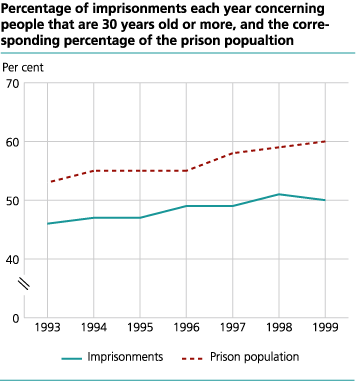Content
Published:
This is an archived release.
Prisoners are getting older
One of the well-established findings in crime statistics is that young men have a higher imprisonment rate than other groups in society. Data from the 1990s indicates that the incarcerated are getting older, while men are still overrepresented.
Exactly half of all imprisonments in Norway in 1999 were of people who were 30 years old or more. Those arrested earlier in the 1990s were generally younger. In 1993, for instance, 46 per cent of new incarcerations were of people in the oldest age category.
More like the rest of the population
This change over a six-year time-span is due in part to changes in the age-structure of the general population. The average age of Norwegians has increased in the same period, but not to the same extent as for those who were put in prison. Hence, the newly imprisoned have become more like the general population, although they have far from the same age-structure. By looking at the Norwegian population of a "punishable" age, i.e. 15 years old or more, we find that 75 per cent of them were 30 years old or more in 1999.
Women are older than men
The women who went to prison in 1999 appear to be older than the men. 59 per cent of women versus 49 per cent of men were in the 30-years-plus age category. Three years earlier, in 1996, those proportions were 56 per cent and 48 per cent, respectively. So it looks like the age of newly imprisoned women have increased more rapidly than that of men. We should note, though, that the vast majority of those imprisoned are men. 92 per cent of all incarcerations in 1999 were of men.
The statistic on the Norwegian prison population, i.e. those in prison at the start of each year, reveals similar trends in terms of age-structure. 60 per cent of prison inmates in 1999 were 30 years old or more, compared with 53 per cent in 1993. Women in prison are also generally older than men; 66 percent of the women versus 60 per cent of the men were 30 years old or more in 1999.
In sum, the age of the Norwegian prison population, and of those imprisoned each year has grown slowly but steadily through the 1990s. There is still a clear relationship between imprisonments and age, in the sense that the imprisoned are younger than the general population. However, that relationship appears to weaken.
Most prisoners are jailed for narcotics crimes
Out of about 11000 imprisonments in Norway in 1999, 2 500 were related to traffic misdemeanors, and 2 300 concerned larceny. Other important grounds for incarceration were narcotics crimes (1 500) and violent crimes (1 000). The available statistic on the prison population at the start of each year is a better measure of which crimes lead to a more substantial time in prison. Only 80 out of the 2 100 prison inmates in 1999 had been incarcerated because of traffic misdemeanors. Most were charged or convicted of more serious crimes such as narcotics crimes (600) or violent crimes (550). One in four prison inmates had not received a conviction in their case; they were held in custody.
Most of the 10 000 releases from Norwegian prisons in 1999 signified the end to a prison time of less than 90 days (7 700). Longer sentences appear to have been reserved for crimes such as murder, rape, serious narcotics crimes, and the sexual abuse of children.
Tables
Contact
-
Susanne Fjelldalen
E-mail: susanne.fjelldalen@ssb.no
tel.: (+47) 40 90 26 43
-
Kristin Bergvall
E-mail: kristin.bergvall@ssb.no
tel.: (+47) 92 66 55 13
-
Reid Jone Stene
E-mail: reid.jone.stene@ssb.no
tel.: (+47) 99 02 22 01

